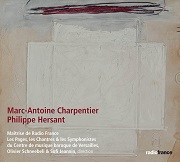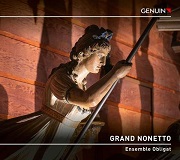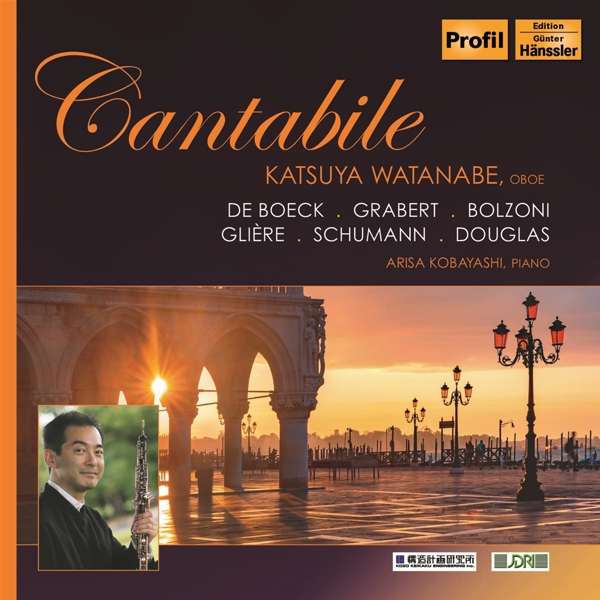Oboen-Gesang
Der Oboist Katsuya Watanabe spielt bei Profil ein anspruchsvolles Programm mit dem Titel Cantabile. Es begreift Musik von August de Boeck, Martin Grabert (Oboensonate op. 52), Giovanni Bolzon, Reinhold Glière (Pieces op. 35), Robert Schumann (Adagio & Allegro) und Bill Douglas (Oboensonate). Watanabe zeigt sich darin erneut als Meister auf der Oboe, als hoch inspirierter Musiker, der mit viel Liebe und Hingabe seinem Instrument und den gespielten Werken dient. Feingeschwungene Linien, dezente Virtuosität, wunderschöner Klang und exzellente Technik zeichnen Watanabes Stil aus. Er wird einfühlsam von Arisa Kobayashi am Klavier begleitet. – Oboist Katsuya Watanabe plays a demanding program on Profil, entitled Cantabile. It comprises music by August de Boeck, Martin Grabert (Oboe Sonata Op. 52), Giovanni Bolzon, Reinhold Glière (Pieces Op. 35), Robert Schumann (Adagio & Allegro) and Bill Douglas (Oboe Sonata). Watanabe once again shows himself to be a master on the oboe, a highly inspired musician who serves his instrument and the music with much love and devotion. Delicate lines, understated virtuosity, beautiful sound and excellent technique distinguish Watanabe’s style. He is sensitively accompanied by Arisa Kobayashi on the piano. (Profil PH20042) – ♪♪♪♪
Miniaturen-Programm mit Lukas Geniusas
Der litauisch-russische Pianist Lukas Geniusas (*1990) spielt die Songs of Bukovina des Gidon Kremer-Freunds Leonid Desyatnikov (*1955). Die Suite von Miniaturen ist eine Hommage an die malerische Region Bukovina auf der Nordseite der Karpaten. Die 24 Stücke sind von Volksliedern inspiriert. Viele sind fröhlich und feierlich, einige traurig, mehrere nachdenklich. Lukas Geniusas spielt sie sehr feinfühlig differenzierend. Das tut er auch in Bartoks 15 Ungarischen Bauernliedern. Er erreicht darin eine ähnlich zwingende Gestaltungskraft, wie sie Zoltan Kocsis in diesem Werk magistral zeigte und die weit über den ethnischen Charakter dieser Musik hinausgeht. – Lithuanian-Russian pianist Lukas Geniusas (b. 1990) plays Songs of Bukovina by Gidon Kremer’s friend Leonid Desyatnikov (b. 1955). The suite of miniatures is a tribute to the picturesque Bukovina region on the northern side of the Carpathian Mountains. The 24 pieces are inspired by folk songs. Many are joyful and solemn, some sad, several reflective. Lukas Geniusas plays them very sensitively, giving each one a distinct character. He does the same in Bartok’s 15 Hungarian Peasant Songs. In them he achieves a similarly compelling interpretation that Zoltan Kocsis magisterially displayed in this work and that goes far beyond the ethnic character of this music. (Mirare MIR440) – ♪♪♪♪
Charpentier versus Hersant
 Die Messe à quatre chœurs von Marc-Antoine Charpentier stellt eine CD von Radio France Editions dem Cantique des trois enfants dans la fournaise von Philippe Hersant gegenüber. Beide sind für gleich starke Kräfte geschrieben, und das sind die Maîtrise de Radio France und Les Pages et les Chantres du Centre de musique baroque de Versailles. Mit ihrer harmonischen Üppigkeit erfährt Charpentiers Messe eine wie erhaben-schwebende, insgesamt sehr lebendige Interpretation. Philippe Hersants Cantique des Trois Enfants fußt auf einer Episode aus dem Buch Daniel: Drei Kinder, die sich weigern, sich Nebukadnezar zu unterwerfen, werden ins Feuer geworfen und beginnen, von Gott gerettet, anstatt vor Schmerz zu schreien, die Schönheiten der Welt und der Natur zu preisen. Hersant schrieb dazu eine bewegende Musik, die von Sofi Janin, der Dirigentin der Maîtrise de Radio France, vielleicht etwas zu zurückhaltend dirigiert wird, letztlich aber im Ganzen doch wirkungsvoll wird. – A CD from Radio France Editions juxtaposes Marc-Antoine Charpentier’s Messe à quatre chœurs with Philippe Hersant’s Cantique des trois enfants dans la fournaise. Both written for equally strong forces. And these are the Maîtrise de Radio France and Les Pages et les Chantres du Centre de musique baroque de Versailles. With its harmonic lushness, Charpentier’s Mass receives what seems like a sublime, floating interpretation that is altogether very lively. Philippe Hersant’s Cantique des Trois Enfants is based on an episode from the Book of Daniel: three children who refuse to submit to Nebuchadnezzar are thrown into the fire and, saved by God, instead of crying out in pain, begin to praise the beauties of the world and nature. Hersant wrote moving music for this, conducted perhaps a bit too restrainedly by Sofi Janin, conductor of the Maîtrise de Radio France, but ultimately effective overall. (1 CD Radio France Editions FRF066) – ♪♪♪
Die Messe à quatre chœurs von Marc-Antoine Charpentier stellt eine CD von Radio France Editions dem Cantique des trois enfants dans la fournaise von Philippe Hersant gegenüber. Beide sind für gleich starke Kräfte geschrieben, und das sind die Maîtrise de Radio France und Les Pages et les Chantres du Centre de musique baroque de Versailles. Mit ihrer harmonischen Üppigkeit erfährt Charpentiers Messe eine wie erhaben-schwebende, insgesamt sehr lebendige Interpretation. Philippe Hersants Cantique des Trois Enfants fußt auf einer Episode aus dem Buch Daniel: Drei Kinder, die sich weigern, sich Nebukadnezar zu unterwerfen, werden ins Feuer geworfen und beginnen, von Gott gerettet, anstatt vor Schmerz zu schreien, die Schönheiten der Welt und der Natur zu preisen. Hersant schrieb dazu eine bewegende Musik, die von Sofi Janin, der Dirigentin der Maîtrise de Radio France, vielleicht etwas zu zurückhaltend dirigiert wird, letztlich aber im Ganzen doch wirkungsvoll wird. – A CD from Radio France Editions juxtaposes Marc-Antoine Charpentier’s Messe à quatre chœurs with Philippe Hersant’s Cantique des trois enfants dans la fournaise. Both written for equally strong forces. And these are the Maîtrise de Radio France and Les Pages et les Chantres du Centre de musique baroque de Versailles. With its harmonic lushness, Charpentier’s Mass receives what seems like a sublime, floating interpretation that is altogether very lively. Philippe Hersant’s Cantique des Trois Enfants is based on an episode from the Book of Daniel: three children who refuse to submit to Nebuchadnezzar are thrown into the fire and, saved by God, instead of crying out in pain, begin to praise the beauties of the world and nature. Hersant wrote moving music for this, conducted perhaps a bit too restrainedly by Sofi Janin, conductor of the Maîtrise de Radio France, but ultimately effective overall. (1 CD Radio France Editions FRF066) – ♪♪♪
Wo sind die Barbaren?
Gusto non Barbaro steht groß auf einer CD des polnischen Labels Recart. Zunächst glaubt man, das sei der Name des Ensembles, das spielt, denn weder vorne noch hinten sind Musikernamen zu sehen. Doch dann stellt es sich heraus, dass dieser Titel bloß Programm ist. Es geht darum, zu beweisen, dass der deutsche Musikstil kein ‘gusto barbaro’, kein barbarischer Stil ist, wie in Italien gesagt wurde. Doch auch im Booklet muss man bis zur Seite 20 blättern, um erste Interpretennamen zu sehen. Es sind die von Wieslaw Surulo, Flöte, Pawel Slecki Fagott, Joanna Solecka und Anna Huszczo, Cembalo. Diese vier spielen Musik von Telemann, C.P.E Bach, Christoph Schaffrath und Johann Joachim Quantz. Aus einem einheitlichen Ensemblegeist heraus gestalten die polnischen Musiker aufblühende Melodien mit sehr viel Einfühlungsvermögen und die schnelleren Sätze temperamentvoll-vital. So bekommt die Musik von manchmal akademisch und uninteressant klingenden Komponisten wie Telemann und Quantz eine gute Qualität. Barbaren mag sich allerdings auch auf das Label beziehen, das seine Künstler, wie oben beschrieben, missachtet. – Gusto non Barbaro is written in large letters on a CD of the Polish label Recart. At first, one thinks that this is the name of the ensemble playing, because there are no names of musicians on the front or back. But then it turns out that this title is just programmatic. The point is to prove that the German musical style is not a ‘gusto barbaro’, not a barbaric style, as the Italians said. But even in the booklet you have to turn to page 20 to see the first performers’ names. They are those of Wieslaw Surulo, flute, Pawel Slecki bassoon, Joanna Solecka and Anna Huszczo, harpsichord. These four play music by Telemann, C.P.E Bach, Christoph Schaffrath and Johann Joachim Quantz. Out of a unified ensemble spirit, the Polish musicians shape blossoming melodies with a great deal of sensitivity and play the faster movements with spirited vitality. Thus the music of sometimes academic and uninteresting-sounding composers like Telemann and Quantz takes on a good quality. Barbaro, however, may also refer to the label disregarding its artists, as described above. (recart 0043) – ♪♪♪♪
Zwei Enneaden
 Auf seiner CD Grand Nonetto spielt das Ensemble Obligat aus Hamburg die Serenade Nr. 1 von Johannes Brahms und Louis Spohrs Nonett F-Dur op. 31. Die Brahms-Serenade, die oft in der orchestrierten Fassung zu hören ist, erklingt hier in der Urfassung für Nonett, und die Musik profitiert sehr vom leichteren Tonsatz. Obligat spielt vital und mit angenehmer Klarheit und trägt so der heiteren Grundstimmung der Komposition Rechnung. Spohrs Nonett op. 31 ist ein Werk der frühen Romantik, dessen Melodik von den Ausführenden ebenso zum Blühen gebracht wird wie die Stimmungsumschwünge kontrastreich und wirkungsvoll angelegt sind. – On its CD On ist CD Grand Nonetto, the Ensemble Obligat from Hamburg plays the Serenade No. 1 by Johannes Brahms and Louis Spohr’s Nonet in F major, op. 31. The Brahms Serenade, which is often heard in the orchestral version, is heard here in the original version for nonet, and the music benefits greatly from the lighter setting. Obligat plays vitally and with pleasing clarity, doing justice to the composition’s generally cheerful mood. Spohr’s Nonet op. 31 is a work of early Romanticism whose melodicism is brought to bloom by the performers just as the mood changes are contrasted and effectively laid out. (Genuin GEN 21759) – ♪♪♪♪
Auf seiner CD Grand Nonetto spielt das Ensemble Obligat aus Hamburg die Serenade Nr. 1 von Johannes Brahms und Louis Spohrs Nonett F-Dur op. 31. Die Brahms-Serenade, die oft in der orchestrierten Fassung zu hören ist, erklingt hier in der Urfassung für Nonett, und die Musik profitiert sehr vom leichteren Tonsatz. Obligat spielt vital und mit angenehmer Klarheit und trägt so der heiteren Grundstimmung der Komposition Rechnung. Spohrs Nonett op. 31 ist ein Werk der frühen Romantik, dessen Melodik von den Ausführenden ebenso zum Blühen gebracht wird wie die Stimmungsumschwünge kontrastreich und wirkungsvoll angelegt sind. – On its CD On ist CD Grand Nonetto, the Ensemble Obligat from Hamburg plays the Serenade No. 1 by Johannes Brahms and Louis Spohr’s Nonet in F major, op. 31. The Brahms Serenade, which is often heard in the orchestral version, is heard here in the original version for nonet, and the music benefits greatly from the lighter setting. Obligat plays vitally and with pleasing clarity, doing justice to the composition’s generally cheerful mood. Spohr’s Nonet op. 31 is a work of early Romanticism whose melodicism is brought to bloom by the performers just as the mood changes are contrasted and effectively laid out. (Genuin GEN 21759) – ♪♪♪♪
Tanzender Buxtehude
Arcangelo (Sophie Gent, Jonathan Manson, Thomas Dunford and Jonathan Cohen) spielt die Triosonaten BuxWV 259-265 von Dietrich Buxtehude (1637-1707). Diese Opus 2 ist die Folge einer Aufnahme mit dem Opus 1 von 2017. Das Ensemble bleibt seinem Stil treu in sehr flüssigen und lebendig tanzenden Interpretationen. – Arcangelo (Sophie Gent, Jonathan Manson, Thomas Dunford and Jonathan Cohen) perform the trio sonatas BuxWV 259-265 by Dietrich Buxtehude (1637-1707). This Opus 2 is a follow-up to a 2017 recording of Opus 1. The ensemble stays true to its style in very fluid and lively dancing interpretations. (Alpha 738) – ♪♪♪♪
https://www.pizzicato.lu/norddeutscher-grosmeister/


















